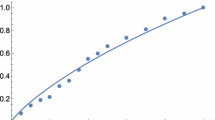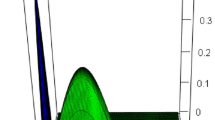Abstract
The bivariate Weibull distribution is an important lifetime distribution in survival analysis. In this paper, Farlie–Gumbel–Morgenstern (FGM) copula and Weibull marginal distribution are used for creating bivariate distribution which is called FGM bivariate Weibull (FGMBW) distribution. FGMBW distribution is used for describing bivariate data that have weak correlation between variables in lifetime data. It is a good alternative to bivariate several lifetime distributions for modeling real-valued data in application. Some properties of the FGMBW distribution are obtained such as product moment, skewness, kurtosis, moment generation function, reliability function and hazard function. Three different estimation methods for parameters estimation are discussed for FGMBW distribution namely; maximum likelihood estimation, inference function for margins method and semi-parametric method. To evaluate the performance of the estimators, a Monte Carlo simulations study is conducted to compare the preferences between estimation methods. Also, a real data set is introduced, analyzed to investigate the model and useful results are obtained for illustrative purposes.





Similar content being viewed by others
References
Basu AP (1971) Bivariate failure rate. J Am Stat Assoc 66(333):103–104
Chen X (2007) Large sample sieve estimation of semi-nonparametric models. Handb Econom 6:5549–5632
Elaal MKA, Jarwan RS (2017) Inference of bivariate generalized exponential distribution based on copula functions. Appl Math Sci 11(24):1155–1186
Flores AQ (2009) Testing copula functions as a method to derive bivariate Weibull distributions. Am Polit Sci Assoc (APSA) 2009:3–6
Fredricks GA, Nelsen RB (2007) On the relationship between Spearman’s rho and Kendall’s tau for pairs of continuous random variables. J Stat Plan Inference 137(7):2143–2150
Galiani SS (2003) Copula functions and their application in pricing and risk managing multiname credit derivative products. University of London Master of Science Project
Genest C, Huang W, Dufour J-M (2013) A regularized goodness-of-fit test for copulas. J Soc Fran Stat 154:64–77
Gumbel EJ (1960) Bivariate exponential distributions. J Am Stat Assoc 55:698–707
Joe H (2005) Asymptotic efficiency of the two-stage estimation method for copulabased models. J Multivar Anal 94:401–419
Kim G, Silvapulle MJ, Silvapulle P (2007) Comparison of semiparametric and parametric methods for estimating copulas. Comput Stat Data Anal 51(6):2836–2850
Kotz S, Balakrishnan N, Johnson NL (2004) Continuous multivariate distributions, volume 1: models and applications, vol 1. Wiley, Hoboken
Kundu D, Dey AK (2009) Estimating the parameters of the Marshall–Olkin bivariate Weibull distribution by EM algorithm. Comput Stat Data Anal 53(4):956–965
Kundu D, Gupta AK (2013) Bayes estimation for the Marshall–Olkin bivariate Weibull distribution. Comput Stat Data Anal 57(1):271–281
Mardia KV (1970) Measures of multivariate skewness and kurtosis with applications. Biometrika 57(3):519–530
McGilchrist CA, Aisbett CW (1991) Regression with frailty in survival analysis. Biometrics 47:461–466
Nelsen RB (2006) An introduction to copulas. Springer, New York
Osmetti SA, Chiodini PM (2011) A method of moments to estimate bivariate survival functions: the copula approach. Statistica 71(4):469–488
Sklar A (1973) Random variables, joint distributions, and copulas. Kybernetica 9:449–460
Tsukahara H (2005) Semiparametric estimation in copula models. Can J Stat 33(3):357–375
Weiß G (2011) Copula parameter estimation by maximum-likelihood and minimum-distance estimators: a simulation study. Comput Stat 26(1):31–54
Author information
Authors and Affiliations
Corresponding author
Additional information
Publisher’s Note
Springer Nature remains neutral with regard to jurisdictional claims in published maps and institutional affiliations.
Rights and permissions
About this article
Cite this article
Almetwally, E.M., Muhammed, H.Z. & El-Sherpieny, ES.A. Bivariate Weibull Distribution: Properties and Different Methods of Estimation. Ann. Data. Sci. 7, 163–193 (2020). https://doi.org/10.1007/s40745-019-00197-5
Received:
Revised:
Accepted:
Published:
Issue Date:
DOI: https://doi.org/10.1007/s40745-019-00197-5




